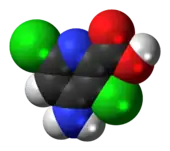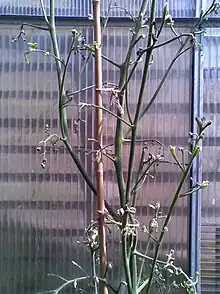Aminopyralid
Aminopyralid is a selective herbicide used for control of broadleaf weeds, especially thistles and clovers. It is in the picolinic acid family of herbicides, which also includes clopyralid, picloram, triclopyr, and several less common herbicides.[2][3] It was first registered for use in 2005, in the USA under the brand name "Milestone"[4] and later under various names starting with "Grazon".[5] In the UK it is sold under the brand names Banish, Forefront, Halcyon, Pharaoh, Pro-Banish, Runway, Synero, and Upfront.
 | |
 | |
| Names | |
|---|---|
| Preferred IUPAC name
4-Amino-3,6-dichloropyridine-2-carboxylic acid | |
| Other names
4-Amino-3,6-dichloropicolinic acid | |
| Identifiers | |
3D model (JSmol) |
|
| ChemSpider | |
| ECHA InfoCard | 100.110.366 |
PubChem CID |
|
| UNII | |
CompTox Dashboard (EPA) |
|
| |
| |
| Properties | |
| C6H4Cl2N2O2 | |
| Molar mass | 207.01416 g/mole |
| Appearance | Off-white powder |
| Density | 1.72 (20°C, relative to water at 4°C) |
| Melting point | 161.75 to 165.23 °C (323.15 to 329.41 °F; 434.90 to 438.38 K) |
Except where otherwise noted, data are given for materials in their standard state (at 25 °C [77 °F], 100 kPa).
Infobox references | |
Aminopyralid is of concern to vegetable growers, as it can enter the food chain via manure, which contains long-lasting residues of the herbicide. It affects potatoes, tomatoes, and beans, causing deformed plants, and poor or non-existent yields. Problems with manure contaminated with aminopyralid residue surfaced in the UK in June and July 2008, and, at the end of July 2008, Dow AgroSciences implemented an immediate suspension of UK sales and use of herbicides containing aminopyralid.[6]

Approval of aminopyralid was subsequently reinstated in the UK on October 6, 2009, as reported by the UK regulatory authority, the Advisory Committee on Pesticides.[7] The re-introduction was approved "with new recommendations and a stringent stewardship programme devised to prevent inadvertent movement of manure from farms".[8]: 22
Despite restrictions, symptoms of aminopyralid damage were recorded on crops growing in allotments in Edinburgh, UK as recently as June 2010; enquiries traced the source of contamination to a farm supplying hay to the stables from where bags of manure had been obtained. Symptoms of aminopyralid injury to vegetable crops were reported by small farmers and gardeners in Britain in July 2011.[9]
References
- Aminopyralid - Compound Summary, PubChem.
- Staff, Virginia Tech Cooperative Extension. Revised May 14, 2012 Pyridine Herbicide Carryover: Causes and Precautions Archived 2016-11-30 at the Wayback Machine Accessed May 27, 2013
- Bob Hartzler, extension weed management specialist, Department of Agronomy, Iowa State University. February 21, 2006 Aminopyralid - New herbicide for pastures, roadsides, etc. Archived 2014-11-03 at the Wayback Machine Accessed May 27, 2013
- Milestone FAQ
- GrazonNext HL Herbicide Accessed 20190203 -- for other name variations, do a google search on Grazon and Aminopyralid.
- Statement from Dow AgroSciences regarding suspension of Aminopyralid products in the UK Archived September 8, 2008, at the Wayback Machine
- Staff, Advisory Committee on Pesticides Aminopyralid - New Approvals Accessed May 27, 2013
- Staff, FarmBusiness. October 23, 2009 AMINOPYRALID Aminopyralid Reapproved for Grassland Archived 2016-03-05 at the Wayback Machine
- 'George Monbiot for The Guardian. July 15, 2011. Have you spotted a strange curling disease in your home-grown veg?